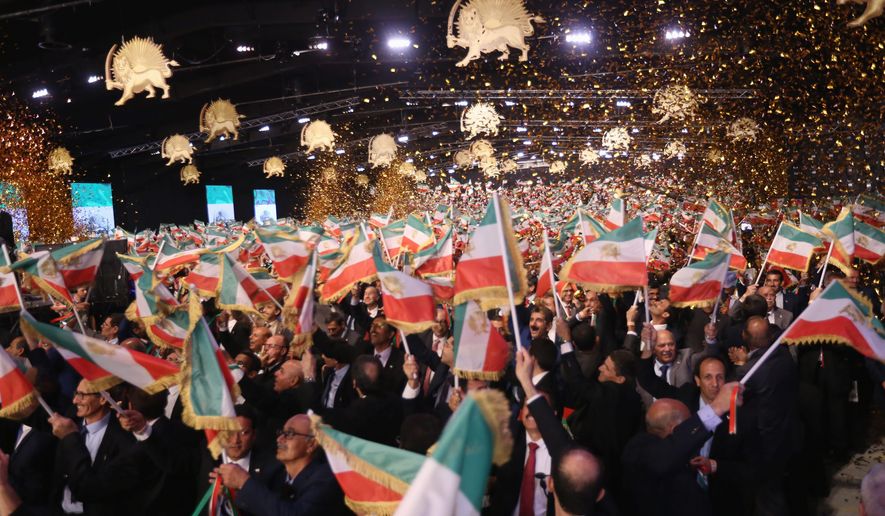ASHRAF-3, Albania — Iran’s largest opposition group opened the doors of its new home base on Saturday with a wave of praise from political leaders from both the left and the right, hailing from nearly 50 countries and all enthusiastic about the group and its goals.
The Ashraf-3 community, not quite finished, rests on a sprawling plot that until 30 months ago was farmland. It is about halfway between the Albanian capital of Tirana and the Adriatic coastline.
Home to more than 3,000 Iranian dissidents from the Mujahedeen-e-Khalq, best known as MEK, Ashraf-3 is too new to appear on map programs. Cement was still drying around the base of some flag posts, and workers were painting the handrails on a bridge as more than 350 dignitaries from 47 countries arrived.
The gathering was MEK’s 15th “Free Iran” event but the first in Albania. Paris hosted the event From 2004 to 2018.
“We look at the fact that so many leaders came to our home so far from where they live as a testament to the international support that exists for MEK and the faith they have in what we want to accomplish,” said Mohammad Mohaddessin, chairman of the foreign affairs committee for the National Council of Resistance of Iran, an umbrella group that includes the MEK.
The two main themes from dozens of speakers were praise for building Ashraf-3 and organizing the event, and a desire to see the Iranian regime toppled.
Changing the regime is the central goal of the MEK, though its formal aim is to step into the void that a collapsed Iranian government would leave only long enough to hold free elections and establish a secular state.
Under the plan, Maryam Rajavi would step in as president-elect until elections are held. Mrs. Rajavi — the wife of MEK co-founder Massoud Rajavi, who disappeared in 2003 — was the star of Saturday’s event. Her remarks were interrupted repeatedly by loud chants of “Iran! Maryam! Freedom!” and “From Ashraf to Tehran, we will fight to the end!”
MEK does not formally take sides in internal politics in other countries, and the delegation from the United States included figures from across the political spectrum. But in her opening remarks, Mrs. Rajavi appeared to endorse President Trump, who helped raise MEK’s profile after pulling out of the Iran nuclear deal last year.
Iran’s “calculation is that terrorist operations and the warmongering in the region’s countries will not cost them very much, at least until the next U.S. presidential election,” she said. “They say to themselves: ‘Let’s wait another 16 months and maybe the U.S. will have another president from whom we can extract the same super concessions as we did with the nuclear deal.’”
She said that strategy would fail in the face of MEK’s efforts. “We will never abandon our struggle,” Mrs. Rajavi said.
“This isn’t a choice between deposing a dictator when we don’t know if an even more terrible leader will take his place,” said former New York City Mayor Rudolph W. Giuliani, a legal adviser to Mr. Trump. “It’s a choice between one of the most terrible sponsors of terrorism in the world in the current regime in Iran, and we have MEK ready to step in.”
Joseph Lieberman, a former senator and the 2000 Democratic vice presidential candidate, said, “You don’t just represent an alternative to the Iranian mullahs. You represent the right alternative.”
MEK was founded in 1965 when several student groups united to oppose the Iranian shah. It has gone through several phases of development as it has battled the Islamic Republic in Tehran, including a period of more than 15 years starting in 1997 when the U.S. government officially classified it as a terrorist organization.
The Obama administration lifted the MEK’s designation as a terrorist group in 2012, citing what it said was the group’s “public renunciation of violence, the absence of confirmed acts of terrorism by the MEK for more than a decade, and their cooperation in the peaceful closure of Camp Ashraf, their historic paramilitary base.” A State Department spokesman at the time said Washington did not claim the exile group was involved in the assassination of scientists in Iran.
But Iranian officials have targeted MEK … and Ashraf-3 includes a museum that details the torture and deaths of as many as 120,000 MEK supporters. In 2015, Iran launched a 40-rocket attack against Ashraf-2, MEK’s previous home in Iraq, leaving 24 dead. A car bomb attack on Ashraf-3 last year was foiled before explosives could be detonated.
Despite the risks, sisters Forough and Hejrat Moezzi, ages 30 and 31, respectively, say Ashraf-3 is the first place that feels like home to them since they left Iran 12 years ago. Both were residents of Ashraf-1 and Ashraf-2 in Iraq.
Ashraf-3 was built in Albania because the country offered refuge to the group. Former Albanian Prime Minister Pandeli Majko explained that the move was part of the country’s history. “In 1943, the Nazis conquered Albania and had two main demands when an Albanian delegation went to Berlin,” Mr. Majko said. “They wanted our gold transferred to Berlin, and they wanted a list of all the Jews in Albania. Our answer was simple: the gold, yes; the Jews, no. Protecting those in need is part of our identity.”
The speed with which the heavily guarded town was built — complete with parks, conference halls, shopping centers, restaurants, swimming pools and a luxury hotel — was enough to make Mr. Giuliani marvel. “This whole city was built in less than two years,” Mr. Giuliani said. “If we tried to do this in New York, it would take 15 years and launch 14 corruption investigations.”
This excerpt is from a Washington Times staff-written news article first published online on July 14, 2019.




Please read our comment policy before commenting.